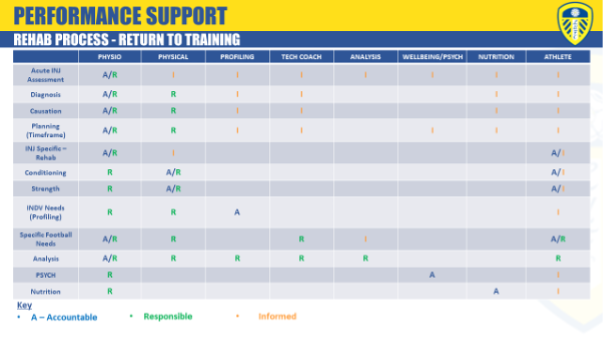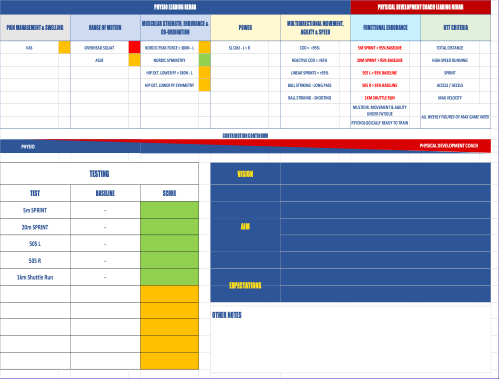A Multidisciplinary approach to a successful return to training post injury in academy football
George Bell (BSc, MSc),
Head of Academy Physical Development at Leeds United FC
Rehabilitation in elite football has continued to develop over the years. Injuries place a significant burden on both the individual player along with a financial & availability dilemma for the club involved. In an elite environment, Return to Training (RTT) is a dynamic process balancing the benefits and risks of RTT to the player and the team. In this case it is vital we are doing everything we can to minimize the risk of these situations. As we all know prevention of all injuries is an unrealistic goal as there are often too many uncontrollable factors, therefore it is necessary that support teams have the systems in place to best prepare the player for returning to training while aiming to mitigate the risk of reinjury. A multidisciplinary team (MDT) approach ensures that there is input at various stages from all departments, for example early integration with the wellbeing team to ensure the player has the help they need dealing with the news that they may be spending some time on the side-lines. Ensuring they have on-going meetings with the analysts so that when they return, they fully understand the system they are coming back into and what is expected of them. When an academy player sustains an injury, I view it as a window of opportunity for physical development. It should be the aim of the MDT to return the player in a better place than pre-injury across all areas.
Below is a table suggesting who is accountable and responsible for the actions and who needs to be informed at each stage of the process (Table 1). This ensures effective communication between the MDT. The input from one member of the MDT is as valuable as any other in the development of the player. For example, an injury has the potential to negatively effect the technical and tactical development of the athlete, therefore the input from both the technical and analysis staff will help ensure the continued development in these areas. Keeping the player involved at all stages of the process helps with buy in and understanding of the system they will follow whilst also building trust with the rest of the MDT.
Table 1: Accountability, Responsibility, and Informed personnel in the RTT process
Research such as ‘Progressing rehabilitation after injury: consider the ‘control-chaos continuum’[1]’ has provided an invaluable framework for all practitioners to base their rehab plans around. Using retrospective player chronic running loads (GPS) in conjunction with estimated tissue healing times, they propose a five-phase framework. Progressing from high control through to high chaos prior to returning to training. Similarly, we currently use a 7-stage continuum for RTT (Table 2) where the input and the accountability from the physical development team gradually increases over time. Chronic running loads set the benchmark for future planning. The end goal for pitch-based rehab is for the player to return capable of surpassing pre-injury chronic running loads. This will ensure that the player is capable of handling the physical demands of the team training upon their return.
Progression from each stage requires accompanying strength and power diagnostics to ensure they are coping with the loads and seeing improvements where necessary. We the physical development team will monitor and assist with the prescription of the GPS metrics. We focus on 5 key metrics which are listed below (Table 3). While planning the return to training it is also important to consider the number of contextual factors in affect such as – player position, team shape/tactics, future direction of the player (loan/1st team) and the periodised weekly micro-cycle of the squad to ensure the end stage rehab in particular mirrors that of the squad.
Table 2: 7 stage RTT continuum
Table 3: Running load metrics used in the planning of pitch bases rehab
During early-stage rehab session content remains general with limited football-specific training. Although we look to integrate a football to the rehab as early as possible. Live GPS monitoring is used to control session output although it is not always completely dictated by a number. As shown below it is not always possible to stick to the numbers set out at the beginning of the week, the important fact is to aim to progressively increase loads as symptoms allow. You must be willing to adapt based on the individual’s response to the stimulus. When planning running loads, it is important to consider that the injured player will have little to no chronic load in comparison to the fit player, therefore the progressions in work loads needs to be considered closely. The progress of running metrics cannot be uniform across all players or injury type due to several factors such as healing times, injury type, playing position demands and the individual response to training. Below is an example of player A’s return to training progression with 1-2 weeks to full return (Figure 1).
Figure 1: Player A’s GPS RTT Metrics
We ensure we have an individual development plan (IDP) for each player. Prior to injury all players will be profiled across several tests and then compared to the benchmark (Club and PL). A list of our testing battery is provided below (Table 4). This tells us the players who are above the minimum standard we set for the given test or if they are below and need a particular focus in this area.
Testing is split into 4 separate categories:
FAST – FIT – STRONG – AGILE
For each category we then assess whether the athlete falls into one of four areas based on their testing results ranging from:
See example individual report below (Figure 2).
Figure 2: Individual Development Plan
This helps during the early-stage planning as we can discuss areas which the individual may need some additional work. It also includes the players physiological profile which will help inform us how to get the most out of that individual.
Table 4: Testing Battery
As soon as a player can start to reintegrate into parts of the squad session we will look to do so. Even when a player fully returns to training, they will still have some ongoing specific programming depending on the injury. Depending on the manager the integration of the player may look different. Some managers are happy for the player to join back in to certain elements of the training then return to the rehab coach for parts they are not yet allowed join into. For example, they may do the squad warm up, passing drill and then back with the rehab coach. Other coaches would rather the player didn’t return until they could partake in the full session.
A standardised approach to this fundamental of sports performance will benefit both the athlete and the performance support team. Having a shared decision-making process in place will ensure a smooth transition from onset of injury through to RTT. At various stages of the rehab process the accountability, reliability, and the need to be informed will affect different members of the MDT. Pre-injury data both GPS and testing will help inform RTT planning. Having an IDP for each player ensures that during the rehab process specific weaknesses can get the necessary attention required. As we are aware prevention of all injuries is unrealistic, having the adequate systems in place and the input from the full MDT will ensure that the athlete returns in the best possible condition.
Credit must go to all members of the performance support department past and present as if it wasn’t for their expert knowledge and input, we would not be at the stage we currently are.
(1) Taberner, M., Allen, T. and Cohen, D.D., 2019. Progressing rehabilitation after injury: consider the ‘control-chaos continuum’. British journal of sports medicine, 53(18), pp.1132-1136.









